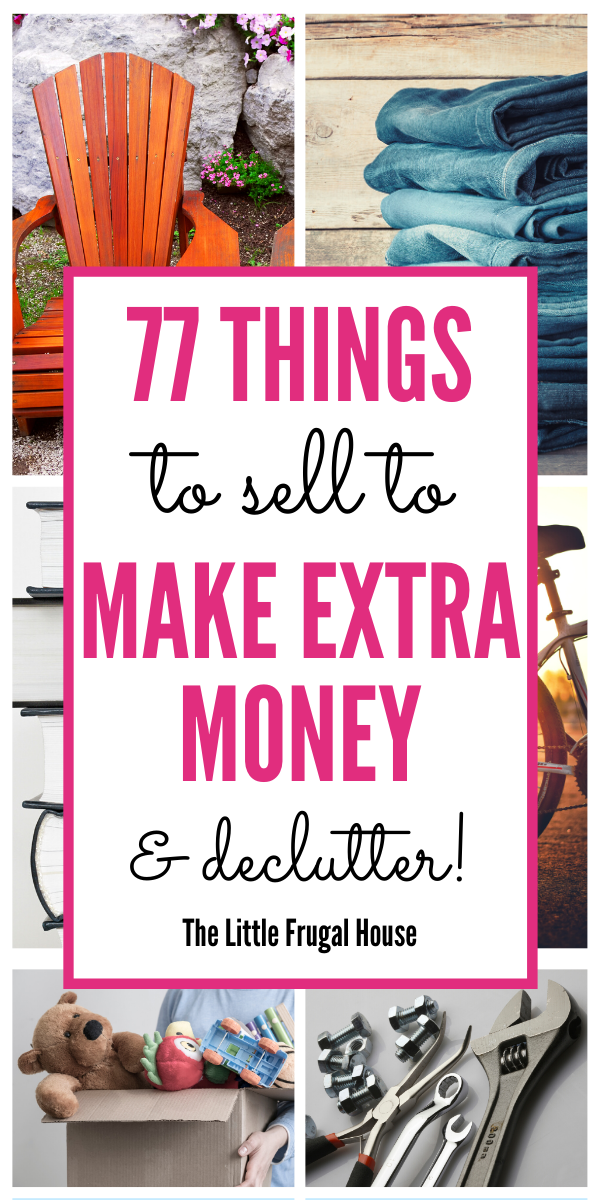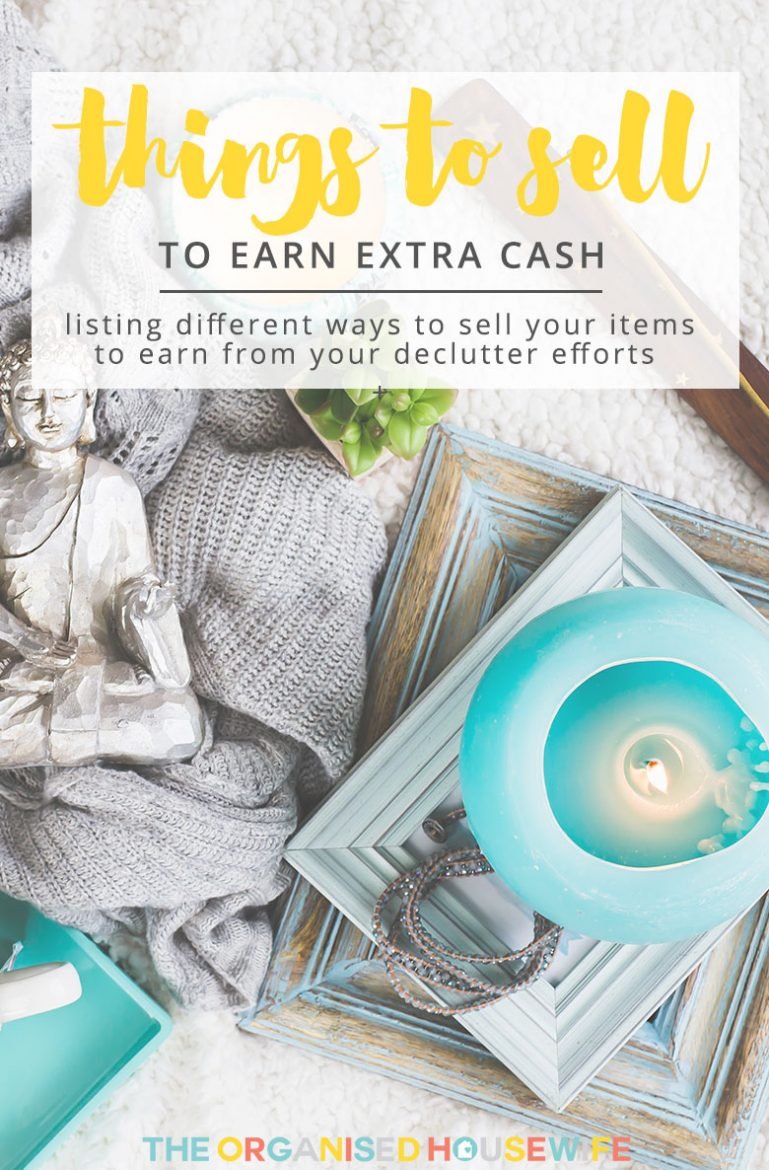From Clutter to Cash: The Ultimate Guide to Decluttering and Selling Your Stuff
If you’re tired of the clutter in your home and could use some extra cash, look no further than decluttering and selling those unused items. Not only will you be able to create a more organized living space, but you’ll also make some extra money in the process. From old clothing and electronics to furniture and household appliances, there is a market for almost everything. With a little effort and determination, you can turn your unwanted belongings into valuable assets. So, clear out those closets and start earning some cash today!

Why Decluttering and Selling Items is Beneficial
Creates more space
Decluttering and selling items that you no longer need is a great way to create more space in your home. Over time, we tend to accumulate a lot of stuff that we don’t use or need anymore. By decluttering and getting rid of these items, you free up valuable space in your home. This can make your living space feel more open and less cluttered, which can have a positive impact on your overall well-being.
Reduces clutter
Clutter can be overwhelming and stressful, making it difficult to find what you need when you need it. By decluttering and selling items, you can effectively reduce the amount of clutter in your home. Having a clutter-free environment can create a sense of calm and order, making it easier to find things and maintain a tidy living space. When your home is organized and free from unnecessary items, it can also contribute to a more peaceful and relaxing atmosphere.
Makes your home more organized
One of the main benefits of decluttering and selling items is that it helps to make your home more organized. When you have fewer things to manage and keep track of, it becomes easier to establish systems and maintain order. By going through your possessions and deciding which ones to sell, you are essentially taking control of your living space. You can create designated areas for different items, making it easier to find and access them when needed. An organized home can also save you time and reduce stress in the long run.
Provides a fresh start
Decluttering and selling items can provide you with a fresh start. Letting go of things that no longer serve you can be liberating and allow you to move forward with a renewed sense of purpose. It can open up new possibilities and opportunities in your life. Whether you’re downsizing, relocating, or simply wanting to simplify your lifestyle, decluttering and selling items can be the first step towards creating the life you desire. It’s a chance to create a clean slate and make room for new experiences and adventures.
Generates extra cash
Perhaps one of the most enticing benefits of decluttering and selling items is the opportunity to generate extra cash. Many of the items that you no longer need or want may still hold value for others. By selling these items, you can turn your clutter into cash. This extra income can be used to pay off debt, save for a vacation, invest in something meaningful, or simply pad your savings account. Selling items that you no longer need is not only a financially smart decision but also a sustainable way to recycle and repurpose goods.
Step 1: Assessing and Sorting Your Possessions
Determine the purpose of decluttering
Before you begin the decluttering process, it’s important to determine your purpose. Are you decluttering to create more space, simplify your life, or generate extra cash? Understanding your goals will help you stay motivated and focused throughout the process.
Set goals and timelines
To stay organized and avoid becoming overwhelmed, set specific goals and timelines for your decluttering project. Break down your possessions into manageable categories and assign each category a timeline for completion. This will help you stay on track and give you a sense of accomplishment as you reach each milestone.
Create categories for items
When sorting through your possessions, create categories that make sense for you. Common categories include items to keep, items to sell, items to donate, and items to discard. Having clear categories will make the decluttering process more efficient and easier to manage.
Evaluate sentimental value
Sentimental items can be the most challenging to declutter. Take the time to evaluate the true sentimental value of each item. If it doesn’t bring you joy or serve a practical purpose, consider selling or donating it. Remember, you can always take photos of sentimental items to preserve the memories without the physical clutter.
Decide on the best method of selling
Consider the type and condition of the items you want to sell when deciding on the best method. For valuable or niche items, online marketplaces like eBay or specialized websites and apps may be your best option. For clothing and accessories, platforms like Poshmark or local consignment stores can be a great choice. Garage sales or flea markets are ideal for selling a variety of items quickly, while social media groups or pages can be effective for reaching a local audience.
Step 2: Organizing and Preparing for Selling
Clean and repair items
Before you sell any item, take the time to clean it thoroughly and make any necessary repairs. Items that are clean and in good condition are more likely to sell quickly and for a higher price. A little effort in cleaning and fixing things up can go a long way in attracting buyers and maximizing your profits.
Find suitable storage solutions
While you’re in the process of sorting and organizing your possessions, it’s important to find suitable storage solutions for the items you choose to keep. Invest in storage bins, shelves, or other organizing tools to keep your remaining items neat and easily accessible. This will not only help you maintain a clutter-free home but also make it easier to sell items in the future if needed.
Take high-quality photos
When it comes to selling items online, high-quality photos are crucial. Invest in a good camera or use the best camera on your phone to capture clear, well-lit images of your items. Take photos from multiple angles and include any relevant details. High-quality photos will attract more potential buyers and increase the likelihood of a sale.
Write detailed product descriptions
Along with high-quality photos, well-written product descriptions are essential for selling your items. Be honest and accurate in your descriptions, highlighting any unique features or selling points. Include measurements, brand names, and details about the item’s condition. Clear and detailed descriptions will help potential buyers make informed decisions and reduce the likelihood of returns or disputes.
Research market value
Before setting prices for your items, it’s crucial to research their market value. Look for similar items on the chosen selling platform and note the prices they are being listed for and sold at. Take into account the condition, demand, and original price of your items when determining a competitive price. Pricing your items appropriately will attract buyers and increase the chances of a successful sale.
Step 3: Choosing the Right Selling Platforms
Online marketplaces (e.g., eBay, Craigslist, Facebook Marketplace)
Online marketplaces offer a wide reach and are convenient for selling a variety of items. Platforms like eBay, Craigslist, and Facebook Marketplace allow you to reach a large audience and easily connect with potential buyers. Take advantage of these platforms by uploading your high-quality photos and detailed product descriptions to attract potential buyers.
Specialized websites or apps for specific categories (e.g., Poshmark for clothing)
For specific categories such as clothing and accessories, consider using specialized websites or apps. Platforms like Poshmark, Depop, or Vinted are designed specifically for selling fashion items. They attract buyers who are specifically looking for clothing and provide additional features tailored to these categories.
Local consignment stores
If you prefer a more hands-off approach, local consignment stores can be a great option. These stores will handle the selling process for you, including pricing, displaying, and promoting your items. While they may take a portion of the sale price as a commission, it can be a convenient way to sell your items without the hassle of dealing with online platforms or shipping.
Garage sales or flea markets
Garage sales or flea markets are ideal for selling a large number of items quickly. These events attract bargain hunters and allow you to sell items directly to customers. Set up an organized display, price your items competitively, and be prepared to negotiate with potential buyers. Advertise your garage sale or flea market booth locally to maximize exposure.
Social media groups or pages
Social media groups or pages dedicated to buying and selling can be a powerful tool for reaching a local audience. Join local buy/sell/trade groups or create a dedicated page for your items. Share your listings in these groups or on your page, and don’t forget to utilize hashtags and keywords to increase visibility. Engage with potential buyers and respond promptly to inquiries to boost your chances of a successful sale.

Step 4: Setting Prices and Negotiating
Research similar listings to determine competitive prices
To set competitive prices for your items, research similar listings on your chosen selling platform. Note the prices that similar items are listed for and sold at. Take into consideration the condition, demand, and original price of your items when setting your prices. Pricing your items competitively will attract buyers and increase the chances of a successful sale.
Consider the condition, demand, and original price
When setting prices for your items, take into account their condition, demand, and original price. Items in excellent condition or high demand may sell for higher prices. On the other hand, items in fair condition or with lower demand may require lower prices to attract buyers. Consider the value that your items hold for potential buyers and price accordingly.
Decide whether to set fixed prices or allow negotiations
When selling items, you have the option of setting fixed prices or allowing negotiations. For rare or high-value items, you may want to set a fixed price to maximize your profits. However, for items with less demand or that you’re more motivated to sell quickly, allowing negotiations can attract more potential buyers. Consider your goals and the market demand when deciding on your pricing strategy.
Be open to reasonable offers
When negotiating with potential buyers, it’s important to be open to reasonable offers. Remember that your goal is to sell your items and generate extra cash. Consider lower offers that still align with your desired price range. Being flexible and accommodating can increase the chances of a successful sale and a positive selling experience.
Use negotiation tactics to maximize profits
While being open to reasonable offers, it’s also important to use negotiation tactics to maximize your profits. Set a realistic starting price, leaving room for negotiations. Highlight the features or benefits of your items to justify the price. Consider bundling items together or offering discounts for multiple purchases. Negotiate in a friendly and assertive manner to achieve a win-win outcome for both parties.
Step 5: Promoting Your Items
Write compelling headlines
When promoting your items, start by writing compelling headlines. Use descriptive and attention-grabbing phrases to entice potential buyers. Highlight unique features or special qualities of your items to make them stand out in a sea of listings. A well-crafted headline can capture the interest of potential buyers and encourage them to click on your listing.
Utilize keywords and tags for better visibility
To improve the visibility of your listings, utilize keywords and tags. Research popular and relevant keywords related to your items and incorporate them into your product descriptions, titles, and tags. This will help potential buyers find your listings when they search for specific items or categories.
Share listings on social media
Leverage the power of social media by sharing your listings on your personal accounts or dedicated selling pages. Take advantage of platforms like Facebook, Instagram, or Twitter, and share eye-catching photos and compelling descriptions. Engage with your followers and ask them to help spread the word by sharing your listings with their networks.
Leverage personal network
Don’t underestimate the power of your personal network when it comes to selling items. Let your friends, family, and colleagues know about the items you are selling. Word-of-mouth recommendations from people who know and trust you can be incredibly effective in generating interest and attracting potential buyers.
Consider paid advertising options
If you’re looking to reach a broader audience, consider investing in paid advertising options. Many online selling platforms offer advertising features that can increase the visibility of your listings. Choose targeted advertisements that reach your desired audience and monitor the results to adjust your advertising strategy if necessary.

Step 6: Handling Inquiries and Negotiations
Respond promptly and professionally to inquiries
When potential buyers inquire about your items, it’s important to respond promptly and professionally. Aim to reply within a reasonable time frame, ideally within 24 hours. Be courteous and helpful in your responses, providing any additional information or photos they may request. Prompt and professional communication can build trust with potential buyers and increase the likelihood of a successful sale.
Provide additional information or photos upon request
Some buyers may require additional information or photos before making a purchasing decision. Be prepared to accommodate these requests promptly and accurately. Provide detailed descriptions or additional pictures to address any concerns or questions potential buyers may have. Going the extra mile to satisfy their inquiries shows your commitment to customer satisfaction and can increase trust in your listings.
Be flexible in arranging meet-ups or shipments
When finalizing the sale, be flexible in arranging meet-ups or shipments according to the buyer’s preferences. Accommodate reasonable requests for location, timing, or shipping options. Ensure clear communication about the logistics of the transaction, including payment methods and any associated costs. Flexibility and a willingness to work with the buyer’s needs can lead to a smoother and more satisfactory selling experience.
Negotiate in a friendly and assertive manner
While negotiating with potential buyers, it’s important to strike a balance between being friendly and assertive. Be respectful and considerate of their offers while advocating for your desired price. Clearly communicate the value of your items and any additional benefits they may offer. Negotiate in a confident and assertive manner to achieve a fair outcome without compromising your interests.
Confirm transaction details in writing
Before finalizing the sale, it’s crucial to confirm transaction details in writing. This can be done through messages or emails. Clearly state the agreed-upon price, any additional terms or conditions, and the chosen method of payment or delivery. Confirming these details in writing helps protect both parties and reduces the likelihood of misunderstandings or disputes.
Step 7: Packaging and Shipping
Choose appropriate packaging materials
When it comes to packaging your sold items, choosing appropriate materials is essential to ensure their safe delivery. Use sturdy boxes, bubble wrap, packing peanuts, or other protective materials to prevent damage during transit. Proper packaging not only protects your items but also reflects positively on your commitment to customer satisfaction.
Ensure items are securely packaged
Before shipping your items, make sure they are securely packaged. Double-check that fragile items are adequately protected and that all parts or components are properly secured. Use packing tape to seal the packages securely and prevent any accidental openings or damage during shipping.
Calculate shipping costs accurately
To avoid confusion or surprises, calculate shipping costs accurately. Consider the weight and dimensions of your packaged items, as well as the chosen shipping method, destination, and any additional services required (e.g., insurance or tracking). Use online shipping calculators or consult with shipping providers to ensure accurate calculations.
Select reliable shipping methods
Choose reliable shipping methods to ensure the safe and timely delivery of your items. Consider using recognized postal services or reputable courier companies. Research customer reviews and ratings for different shipping providers to select the most reliable option. Reliable shipping methods contribute to a positive buying experience and can boost your seller reputation.
Keep records of tracking numbers and receipts
Once your items are shipped, keep records of tracking numbers and receipts as proof of shipment. This information is essential for both you and the buyer to track the delivery status and address any issues that may arise. Good record-keeping demonstrates your professionalism and provides peace of mind to both parties involved in the transaction.

Step 8: Buyer Satisfaction and Feedback
Provide excellent customer service
To build a positive selling reputation, provide excellent customer service. This includes prompt and polite communication, accurate product descriptions, and reliable shipping services. Consider going the extra mile by including a thank-you note or a small gift with the shipped items. Place yourself in the buyer’s shoes and strive to provide the level of service that you would expect as a buyer.
Address issues or concerns promptly
In the unlikely event that a buyer raises an issue or concern, address it promptly and professionally. Listen to their concerns, offer solutions, and be willing to accommodate reasonable requests. By addressing problems in a timely manner, you can turn a potentially negative experience into a positive one and foster a good relationship with the buyer.
Encourage buyers to leave feedback
After completing a successful sale, encourage buyers to leave feedback about their experience. Positive reviews can boost your seller reputation and attract more potential buyers. Politely request feedback and provide instructions on how buyers can do so. Express your appreciation for their time and feedback, as it helps build credibility and trust in your future listings.
Respond to feedback graciously
Whether the feedback is positive or negative, respond to it graciously. Show gratitude for positive feedback and acknowledge any constructive criticism. If drawbacks are mentioned, use the feedback as an opportunity to improve your selling strategies. Responding professionally to feedback demonstrates your commitment to customer satisfaction and further enhances your seller reputation.
Use positive feedback to build credibility
Positive feedback is a valuable asset in building credibility as a seller. Showcase positive feedback on your selling profiles or dedicated pages. Potential buyers often consider the seller’s reputation before making a purchase. Having a track record of positive feedback can instill confidence in potential buyers and increase your chances of making successful sales.
Step 10: Reflecting and Adjusting Strategies
Evaluate the success of your decluttering and selling process
After completing your decluttering and selling process, take the time to evaluate its success. Consider factors such as the amount of clutter reduced, the number of items sold, the profit generated, and the overall experience. Reflecting on your progress will help you see the value and benefits of your efforts.
Identify areas for improvement
As you reflect on your decluttering and selling process, identify areas for improvement. Perhaps there are certain items or categories that didn’t sell as well as expected. Maybe your pricing or negotiation tactics could use some adjustments. Recognize where you can improve and make note of these areas for future initiatives.
Adjust pricing or selling methods if necessary
Based on your evaluation and identified areas for improvement, be open to adjusting your pricing or selling methods. Experiment with different pricing strategies or explore alternative selling platforms. Adapt to market trends and buyer demands to maximize your chances of success.
Consider donating unsold items
If you have unsold items after your selling efforts, consider donating them to charity. Donating can be a rewarding way to repurpose your items and contribute to a good cause. Research local organizations or donation centers that accept the types of items you have. Donating unsold items demonstrates your commitment to sustainability and giving back to the community.
Implement lessons learned for future initiatives
Finally, implement the lessons learned from your decluttering and selling experience into future initiatives. Apply the knowledge and strategies you’ve gained to future decluttering projects or selling endeavors. Continuously improving and refining your process will help you achieve even better results in the future.
By following these steps and taking the time to declutter and sell items you no longer need, you can create more space, reduce clutter, and make your home more organized. Not only that, but you can also provide yourself with a fresh start and generate some extra cash along the way. So, start assessing and sorting your possessions, organizing and preparing for selling, choosing the right selling platforms, setting prices and negotiating, promoting your items, handling inquiries and negotiations, packaging and shipping, ensuring buyer satisfaction, and reflecting and adjusting your strategies. Decluttering and selling can be a rewarding and profitable experience that brings both financial and emotional benefits.


